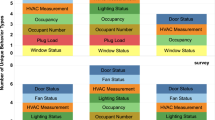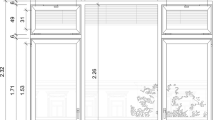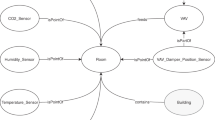Abstract
Within a study, an open plan area and one closed office in a university building with a floor area of around 200 m2 were monitored. The present data set covers a period of one year (from 2013-01-01 to 2013-12-31). The collected data pertains to indoor environmental conditions (temperature, humidity) as well as plug loads and external factors (temperature, humidity, wind speed, and global irradiance) along with occupants’ presence and operation of windows and lights. The monitored data can be used for multiple purposes, including the development and validation of occupancy-related models.
Measurement(s) | Occupancy • room temperature ambient air • humidity • radiation • temperature of air • atmospheric wind speed • atmospheric wind direction • electrical energy |
Technology Type(s) | sensor • Gauge or Meter Device |
Sample Characteristic - Organism | Homo sapiens |
Sample Characteristic - Environment | office building |
Sample Characteristic - Location | Vienna |
Machine-accessible metadata file describing the reported data: https://doi.org/10.6084/m9.figshare.9822623
Similar content being viewed by others
Background & Summary
Professionals in the building design, construction, and operation have become increasingly aware concerning the importance and value of monitored data from buildings1. Such data can support the objective assessment of buildings’ indoor environmental conditions and energy performance. As such, building delivery and commissioning process cannot be considered accountable without an evidence-based monitoring-supported verification2. Moreover, monitored data can support operational optimisation of existing building stock and – accumulated over time and multiple buildings – inform and improve future projects. Energy and performance contracting, smart load balancing, model-predictive building systems control, and preventive building maintenance can all significantly benefit from systematic collection and analysis of monitored data. Likewise, high-quality data can contribute to the state of knowledge in areas such as building physics, building integrity, building automation, indoor environment, and human factors in building performance.
The data included in the present contribution represents a part of an effort toward systematic and comprehensive data collection in an existing office building. The associated process facilitated a better understanding of the shortcomings in the current practices concerning the technical infrastructures for building monitoring and related challenges in hardware scalability and software interoperability. Moreover, the multi-aspect nature of the collected data support the process of ontology development for building-related monitored data. This ontology may be described in terms of a general schema or a structured matrix of multiple data streams originating from, and relevant to, the operation of buildings. This ontology2,3 has been shown to have the potential to enhance the understanding of building-related data space and provide a solid foundation for further developments with respect to applications in building data acquisition, storage, processing, and analysis.
Methods
The present contribution represents the data monitored over a period of one year (from 2013- 01-01 to 2013-12-31) in an office area of around 200 m2 in a university building in Vienna. Figure 1 illustrates the setting and monitoring infrastructure of the office area. Within this study, multi-aspect (thermal, visual, and equipment) data of this office area as well as external conditions are collected.
Table 1 shows the measured variables within this study including information about inhabitants (around eight occupants were monitored), indoor and external conditions, control systems/devices and equipment.
The area layout (see Fig. 1) includes a single-occupancy closed office (O3), two single- occupancy semi-closed offices (O2, O4), an open plan office area (O1), a kitchen (KI), and a meeting room (MR).
The naturally ventilated office area includes eight workstations, in which each occupant has access to one manually operable casement window. Only the enclosed office entails one workstation and two windows. Opening and closing actions are typically conducted on operable internal and external wings of the casement windows. Each window is equipped with internal shading elements. Dimensions of the casement window are given in Fig. 2. Occupants’ window opening behaviour is not likely to have been influenced by circumstances such as traffic noise or poor air quality, given low external ambient sound levels (windows are oriented toward internal courtyards) and relatively low (measured) CO2 levels.
The occupants’ presence, state of windows and a number of indoor environment variables (including indoor air temperature, indoor air relative humidity, and equipment power) are monitored on a continuous basis. The arrangement of the monitoring infrastructure within the office area is given in Table 2.
Table 3 provides an overview of the monitoring infrastructure. Data collection of the indoor climate and the user interactions within the office area was performed with an in-house developed monitoring system concept based on off-the-shelf wireless EnOcean sensors, a wireless telegram data collector and a central web-based monitoring service4.
In detail, the occupancy data has been obtained via wireless ceiling-mounted PIR motion detectors. The sensors are active in interval of 1.6 minutes and detect movements and measure the brightness at ceiling level. Like all sensors based on EnOcean standard, the transmission of the telegrams is reduced to a necessary minimum. The resulting low energy demand is usually covered by a solar cell or a battery. As a result, telegrams were only sent when a value change is higher than a sensor specific minimum or a maximum time difference to the previous telegram was exceeded. The recorded data entails a sequence of time- stamped occupant motion detection with binary values. In order to facilitate data analysis, the event-based data streams were processed to generate 15-minute interval data by the use of stored procedures implemented in the MySQL database of the MOST building monitoring system5,6. In case of occupancy, this stored procedure derives the duration of occupancy states (occupied/vacant) from the stored events and returns the dominant occupancy state of each interval.
Indoor air temperature and relative humidity were measured inside each office area close to each workstation at 0.9 m height. The state of all windows was measured through a window contact sensor. Light state was indirectly measured by the use of an EnOcean-based electric energy meter. The recorded event-based data from the EnOcean-based sensors was subsequently processed by a stored procedure of the MOST building monitoring system to generate the values of the provided data records for each time interval6.
Outdoor environmental parameters (including air temperature, air relative humidity, wind speed, wind direction, and global radiation) are monitored via a local weather station.
The weather station is located on top of the building at about 40 m above street level. No obstacles were situated close by that could potentially influence the wind direction or speed.
Technical Validation
The data included in the present contribution displays an inherently multi-layered nature, involving multiple domains (thermal, visual, equipment) and multiple probes (of different type and built). Moreover, it is relayed and stored via multiple technologies, and processed to fit different categories within the underlying monitoring ontology. Given this nature, evidence of technical validation cannot be presented in terms of a single experimental design. Nonetheless, the long-term data collection and processing effort incorporated a number of measures and operations to ensure the consistency and reliability of the data set. These include:
- (i)
Regular calibration of sensory probes: This was conducted both by third-party instances every three years (specifically regarding the weather station sensors) and via Department’s own climate-chamber for temperature probe output comparison before installation and thereafter (via annual comparisons with a reference probe);
- (ii)
Systemic comparison of output of the probes of the same kind when placed in the same positions;
- (iii)
Recurrent standard quality and plausibility checks toward preventive detection of potential probe output disruption, malfunction, or corruption;
- (iv)
Post-repository pre-submission data distillation excluding all but those data elements meeting the above criteria.
References
Wagner, A., O’Brien, W. & Dong, B. Exploring Occupant Behavior in Buildings. (Springer, 2018).
Mahdavi, A. & Taheri, M. An ontology for building monitoring. J. Build. Perform. Simul. 10, 499–508 (2017).
Mahdavi, A., Glawischnig, S., Schuss, M., Tahmasebi, F. & Heiderer, A. Structured building monitoring: ontologies and platform. In Proceedings of the 11th ECPPM 2016 (eds Christodoulou, S. E. & Scherer, R.). 651–658 (Balkema, 2016).
Schuss, M., Glawischnig, S. & Mahdavi, A. A flexible and scalable approach to building monitoring and diagnostics. In Proceedings of the 11th ECPPM 2016 (eds Christodoulou, S. E. & Scherer, R.). 235–242 (Balkema, 2016).
Zach, R., Schuss, M., Bräuer, R. & Mahdavi, A. Improving building monitoring using a data preprocessing storage engine based on MySQL. In Proceedings of the ECPPM 2012 (eds Gudnason, G. & Scherer, R.). 151–157 (Taylor & Francis, 2012).
Zach, R., Glawischnig, S., Hönisch, M., Appel, R. & Mahdavi, A. MOST. An open-source, vendor and technology independent toolkit for building monitoring data preprocessing, and visualization. In Proceedings of the ECPPM 2012 (eds Gudnason, G. & Scherer, R.). 97–103 (Taylor & Francis, 2012).
Mahdavi, A., Berger, C., Tahmasebi, F. & Schuss, M. Monitored data on occupants’ presence and actions in an office building (dataset). figshare, https://doi.org/10.6084/m9.figshare.9582962 (2019).
Acknowledgements
The design and configuration of the technical infrastructure for the collection of the data included in the present contribution benefited from the participation of Mr. Josef Lechleitner of the Department of Building Physics and Building Ecology, TU Vienna. Efforts to utilize the collected data in various scientific endeavours have benefited from the authors’ participation in IEA EBC Annexes 66 and 79.
Author information
Authors and Affiliations
Contributions
Ardeshir Mahdavi is the initiator and primary conceptual designer of the implemented monitoring strategy and infrastructure. He is also the primary author of building data ontology underlying the scope and structure of the collected data. Christiane Berger participated in drafting the present contribution and data consistency and quality check. Farhang Tahmasebi was responsible for the preparation and organization of the subset of the Department’s monitored data for the purposes of the present contribution. Matthias Schuss is responsible for the operation and maintenance of the monitoring infrastructure and data repository of the Department of Building Physics and Building Ecology.
Corresponding author
Ethics declarations
Competing interests
The authors declare no competing interests.
Additional information
Publisher’s note Springer Nature remains neutral with regard to jurisdictional claims in published maps and institutional affiliations.
Rights and permissions
Open Access This article is licensed under a Creative Commons Attribution 4.0 International License, which permits use, sharing, adaptation, distribution and reproduction in any medium or format, as long as you give appropriate credit to the original author(s) and the source, provide a link to the Creative Commons license, and indicate if changes were made. The images or other third party material in this article are included in the article’s Creative Commons license, unless indicated otherwise in a credit line to the material. If material is not included in the article’s Creative Commons license and your intended use is not permitted by statutory regulation or exceeds the permitted use, you will need to obtain permission directly from the copyright holder. To view a copy of this license, visit http://creativecommons.org/licenses/by/4.0/.
The Creative Commons Public Domain Dedication waiver http://creativecommons.org/publicdomain/zero/1.0/ applies to the metadata files associated with this article.
About this article
Cite this article
Mahdavi, A., Berger, C., Tahmasebi, F. et al. Monitored data on occupants’ presence and actions in an office building. Sci Data 6, 290 (2019). https://doi.org/10.1038/s41597-019-0271-7
Received:
Accepted:
Published:
DOI: https://doi.org/10.1038/s41597-019-0271-7
This article is cited by
-
A Global Building Occupant Behavior Database
Scientific Data (2022)
-
A measured energy use, solar production, and building air leakage dataset for a zero energy commercial building
Scientific Data (2021)
-
The Building Data Genome Project 2, energy meter data from the ASHRAE Great Energy Predictor III competition
Scientific Data (2020)
-
A structured open data collection on occupant behaviour in buildings
Scientific Data (2019)





